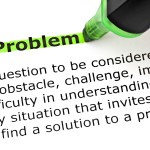Topic 2 – Defining and Phrasing Problems > What’s your problem? > What’s your problem?
- Around the table, directors’ questions were things like how do we find new materials, what’s the most efficient transportation and how do we build it, how do we maximize customer satisfaction? All well and good, but isn’t the true question how do we maximize the efficiency of getting oil and gas from the ground? Don’t all these other concerns miss a good part of the picture? Stop and think.
Topic 2 – Defining and Phrasing Problems > Characteristics of good questions: Ambitious, unbiased > Characteristics of good questions: Ambitious, unbiased
- Central problem statements are questions that have the greatest potential to generate surprising and useful answers have several characteristics – big and ambitious, unbiased by pre-existing beliefs, plausible, actionable, useful.
- Their questions follow along the lines of the visionary ideologies that have been termed Big, Hairy, Audacious Goals, or BHAGs.
- Charles Darwin, the father of evolutionary theory, asked, how did all species come to be? Ernest Rutherford, father of our current model of the atom, asked, what is the fundamental nature of matter? These questions later got broken down into bite-size pieces to be chewed and answered, but an almost outrageously expansive first statement of the question was needed to get at the existing essence of the problem.
- What central big, hairy, audacious question would you suggest?
Topic 2 – Defining and Phrasing Problems > Prying your problem from its box > Prying your problem from its box
- When questions arise from beliefs, their answers will be limited to preexisting traditional assumptions otherwise known as frames.
- If you ask a framed question, you’ll get a framed answer.
- You’d have been asked to choose between two strategies to be used in combating an emerging infection from Asia.
- Strategy A. If adopted, 200 people will be saved.
- Strategy B. One third probability that 600 people will be saved, and two thirds likelihood that no one will be saved.
- Which option would you choose? If you’re like three quarters of their respondents, you chose strategy A, the sure thing, a gain of 200 lives.
- Strategy C. If adopted, 400 people will die.
- Strategy D. One third probability that nobody will die, and two thirds likelihood that 600 people will die.
- Which would you choose? Now three quarters of respondents chose strategy D, the gamble when the problem was framed as a loss of 400 lives.
- To have been consistent after choosing strategy A, you would have selected strategy C, which is the same answer.
Topic 2 – Defining and Phrasing Problems > Characteristics of good questions: Plausible, useful, actionable > Characteristics of Good Questions: Plausible, useful, actionable
- Good questions are plausible, useful, and actionable.
- Plausible, useful, and actionable are reality checks on our question.
- Plausible means the solution is not already established.
- If something works perfectly well, why would we spin our wheels trying to upend it? Useful implies importance, that the question and its possible solutions could impart positive change.
- Example of germ theory, one of the most disruptive innovations of all time. Without germ theory, sanitation, healthy food practices, safe surgery, and antibiotics could not have been conceived.
Topic 2 – Defining and Phrasing Problems > Actionable problems > Actionable problems
- Discussion of actionable problems using an example of the shipping industry in the 1950s.
- Is your key question actionable? If not, re-state the question with all attributes.
Topic 2 – Defining and Phrasing Problems > Giving your question a personality > Giving your question a personality
- Questions will be more grounded and solvable if they’re specific.
- Reverse innovation is a term that refers to inventions developed for the emerging global middle class.
- Give your question a personality – a who, what, when, and where.
Topic 2 – Defining and Phrasing Problems > Going deeper > Going deeper
- Discussion of how to go deeper using the healthcare industry as an example.
Topic 2 – Defining and Phrasing Problems > Discussion of stop & thinks > Discussion of stop & thinks
- Let’s review the characteristics of a principle question most likely to result in innovation.
- Recall that the questions the real consultancy firm asked were – how to respond effectively to the economics of local markets, and how to secure and grow market share? To be bold, we go beyond the specifics of a given market.
- The solution the question generates should be the three reality checks of being non-obvious and impactful as well as potentially achievable.
- The best questions are big, yet specific enough to generate lots of potential innovative solutions.
- When we ask “How” and “Why,” our big and bold question produces sub-questions with implementable – or at least, testable – answers.
Topic 2 – Defining and Phrasing Problems > Topic 2 Wrap-Up > Concept Review
- The best questions are big, yet specific enough to generate lots of potential innovative solutions.
- When we ask how and why, our big and bold question produces sub-questions with implementable or at least testable answers.


